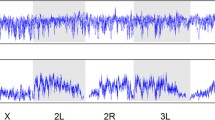Summary
There are several Colombian populations of Drosophila pseudoobscura which have begun to show divergence. The temporal samples of Torobarroso, one of the local populations identified, demonstrate genetic “resourcefulness” and selective opportunism by fluctuating mortality. The data suggest that both balanced selection and mutational origin are necessary to account for the frequencies of drastic genes encountered. In genetic isolates there seems to exist alternatively a mutational component and a balanced — selection component. These components overcome the damage in the first instance and in the second instance, profit from the recessive load.
Similar content being viewed by others
References
Crow JF (1968) Some analysis of hidden variability in Drosophila. In: Lewontin R (ed) Population biology and evolution. Syracuse University Press, Syracuse, pp 71–86
Crow JF, Temin RG (1964) Evidence for the partial dominance of recessive lethal genes in natural populations of Drosophila. Am Nat 98:21–33
Dobzhansky Th, Hunter AS, Pavlovsky O, Spassky B, Wallace B (1963) Genetics of natural populations. 31. Genetics of an isolated marginal population of Drosophila pseudoobscura. Genetics 48:91–103
Greenberg R, Crow JF (1960) A comparison of the effect of lethal and detrimental chromosomes from Drosophila populations. Genetics 45:1153–1168
Hoenigsberg HF, Castro LE, Granobles LA (1969) Drosophila pseudoobscura from Cundinamarca (unpublished)
Hoenigsberg HF, Castro LE, Granobles LA (1972) Population structure of Drosophila pseudoobscura from the Altiplano of Cundinamarca (unpublished)
Hoenigsberg HF, Granobles LA, Hortobagj-German S (1974) The Drosophila pseudoobscura from Cundinamarca and Boyacá (unpublished)
Hoenigsberg HF, Palomino JJ, Hayes MJ, Zandstra IZ, Rojas GG (1977) Population genetics in the American Tropics. 10. Genetic load differences in Drosophila willistoni from Colombia. Evolution 31:805–811
Hoenigsberg HF, Ordoñez M, de Polanco MME, Espinel A (1982) Population genetics in the American Tropics. 16. Data on partial dominance of recessives in Drosophila willistoni. Theor Appl Genet 61:183–191
Lewontin RC (1974) The genetic basis of evolutionary change. Columbia University Press, New York
Polanco MME de, Hoenigsberg HF (1982) Drosophila pseudoobscura from the Colombia Altiplano. Drosophila Inf Serv 58:125
Polanco MME de (1982) Tesis de Magister. Factores genéticoevolutivos determinantes de la micro-evolución de los arreglos de las inversiones paracéntricas del III cromosoma de Drosophila pseudoobscura del Altiplano de Bogotá, Colombia. Biblioteca UNIANDES
Wallace B, Madden C (1953) The frequencies of sub and supervitals in experimental populations of Drosophila melanogaster. Genetics 38:456–470
Wallace B (1968) Topics in population genetics. Norton WW, New York
Author information
Authors and Affiliations
Additional information
Communicated by J. S. F. Barker
This paper is dedicated to Charles Darwin in his centennial
Rights and permissions
About this article
Cite this article
Hoenigsberg, H.F., de Polanco, M.M.E., Monje, C.A. et al. Population genetics in the American Tropics. Theoret. Appl. Genetics 65, 295–301 (1983). https://doi.org/10.1007/BF00276567
Received:
Accepted:
Issue Date:
DOI: https://doi.org/10.1007/BF00276567




